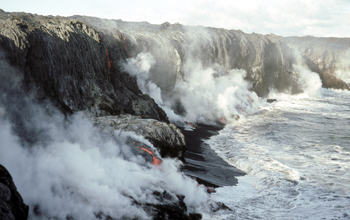Multimedia Gallery
Volcano sea entry point
At the Ka`ili`ili sea entry point of the volcano Kilauea, blocks of hot lava fall into the ocean where they leave glowing trails as they are carried away by the waves. While lava's light density may give it buoyancy, it is mainly due to the heavy concentrations of steam generated when the hot lava hits the cooler water that allow it to float for a period of time before sinking.
More about this image
Kilauea is the youngest and southeastern most volcano on the Big Island of Hawaii. Topographically, Kilauea, which is located on the southernmost flank of Mauna Loa, was thought to be an extension of its giant neighbor. However, research over the past few decades clearly shows that Kilauea has its own magma plumbing system, extending to the surface from more than 60 km deep in the Earth.
The eruption of Kilauea began more than 20 years ago in 1983 (making it one of the world's most active volcanoes and possibly the most active) and continues today at Pu`u `O`o, Kilauea's active vent. As a result, new land is almost constantly created and the vast landscape around the active vent is constantly changing. Lava erupts from the cone and flows through a tube system down Pulama pali, about 11 kilometers to the sea. (Date of Image: February 2005) (Note: This image is copyright. Please see "Special Restrictions" below regarding use of this image.)
Credit: ©Tom Pfeiffer (www.decadevolcano.net/VolcanoDiscovery.com)
See other images like this on your iPhone or iPad download NSF Science Zone on the Apple App Store.
Special Restrictions: This image is copyright. Permission has been granted by the owner, Tom Pfeiffer, to use the image for nonprofit/non-commercial use only. Any other use of this image (including, for example, newspapers, magazines, books or brochures) is strictly prohibited without the explicit permission from Tom Pfeiffer, who can be reached via the websites http://www.decadevolcano.net or http://www.volcanodiscovery.com.
Images and other media in the National Science Foundation Multimedia Gallery are available for use in print and electronic material by NSF employees, members of the media, university staff, teachers and the general public. All media in the gallery are intended for personal, educational and nonprofit/non-commercial use only.
Images credited to the National Science Foundation, a federal agency, are in the public domain. The images were created by employees of the United States Government as part of their official duties or prepared by contractors as "works for hire" for NSF. You may freely use NSF-credited images and, at your discretion, credit NSF with a "Courtesy: National Science Foundation" notation.
Additional information about general usage can be found in Conditions.
Also Available:
Download the high-resolution JPG version of the image. (4.3 MB)
Use your mouse to right-click (Mac users may need to Ctrl-click) the link above and choose the option that will save the file or target to your computer.

